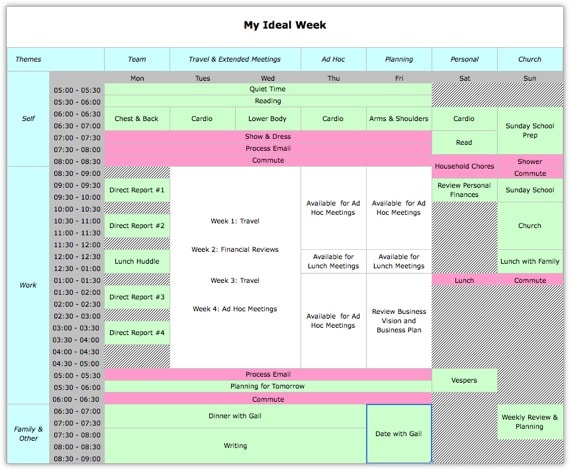You have a choice in life. You can either live on-purpose, according to a plan you’ve set. Or you can live by accident, reacting to the demands of others. The first approach is proactive; the second reactive.
Sure, you can’t plan for everything. Things happen that you can’t anticipate. But it is a whole lot easier to accomplish what really matters when you are proactive and begin with the end in mind. One of the ways I do this is by creating a document, I call “My Ideal Week™.”
I was first introduced to this concept by author Todd Duncan in a series of audio recordings he made that eventually became the book, Time Traps: Proven Strategies for Swamped Salespeople.
The idea is similar to a financial budget. The only difference is that you plan how you will spend your time rather than your money. And like a financial budget, you spend it on paper first. Building Champions, the executive coaching company I recommend, refers to this as a “Time Block.”
My Ideal Week—the week I would live if I could control 100% of what happens—is divided into a simple grid. Each day has a theme. In addition, each day is segmented according to a specific focus area.
On My Ideal Week, daily themes are listed on the very top row:
- Monday is devoted to my team, one-on-one meetings and a staff meeting at lunch.
- Tuesday and Wednesday are devoted to travel and extended meetings, like our Monthly Business Review meetings.
- Thursday is an ad hoc day. This is where I try to push external requests for meetings.
- Friday is spent on planning and long-term thinking
- Saturday is for personal chores and activities.
- Sunday is for church, rest, and planning the next week.
My focus areas are listed in the left-most column:
- The early morning hours are devoted to self: reading, praying, and working out.
- The middle of the day is devoted to work. Note that I arrive at the office by 8:30 and leave promptly at 6:00 p.m. It is amazing what you can get done in the time allotted when you create “hard boundaries” around your work. Otherwise, Parkinson’s Law becomes operative: “Work expands to the time allotted for it.”
- The end of the day is reserved for my family and writing. Currently, I don’t have any children living at home. However, Gail I eat dinner together almost every night, taking time to connect and catch up. I then enjoy writing for the last ninety minutes of the day.
Activities that contribute to my goals and priorities are shaded green. Those are not related to my goals are shaded red. Those that could be either, are white. Those that are grey are simply not scheduled. This represents “margin.” This scheme is admittedly subjective, but it is helpful to me. It ensures that I am working on what really matters.
I highly recommend that you map out your own Ideal Week. Once you have created your Ideal Week, you can use your original document as a basic template for planning each week. I have also found it helpful to give to my assistant, so that we are both working with the same set of expectations.
If you are like me, not everything can be shoe-horned into the template. However, having this document will better enable you to to accomplish those things that matter most.
Disclosure of Material Connection: Some of the links in the post above are “affiliate links.” This means if you click on the link and purchase the item, we will receive an affiliate commission. Regardless, we only recommend products or services we use and believe will add value to our readers. We are disclosing this in accordance with the Federal Trade Commission’s 16 CFR, Part 255: “Guides Concerning the Use of Endorsements and Testimonials in Advertising.










